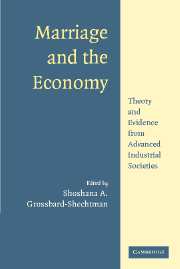Book contents
- Frontmatter
- Contents
- List of Figures
- List of Tables
- List of Contributors
- Foreword
- Acknowledgments
- Marriage and the Economy
- 1 Marriage and the Economy
- PART I THE ECONOMICS OF MARRIAGE AND DIVORCE
- PART II EFFECTS OF MARRIAGE ON INCOME USES
- 5 Control over Money in Marriage
- 6 Marriage, Assets, and Savings
- 7 The Economics of Child Support
- 8 Marriage Prospects and Welfare Use
- PART III EFFECTS OF MARRIAGE ON TIME USES
- PART IV MARRIAGE AND THE MACROECONOMY
- Index
7 - The Economics of Child Support
Published online by Cambridge University Press: 07 December 2009
- Frontmatter
- Contents
- List of Figures
- List of Tables
- List of Contributors
- Foreword
- Acknowledgments
- Marriage and the Economy
- 1 Marriage and the Economy
- PART I THE ECONOMICS OF MARRIAGE AND DIVORCE
- PART II EFFECTS OF MARRIAGE ON INCOME USES
- 5 Control over Money in Marriage
- 6 Marriage, Assets, and Savings
- 7 The Economics of Child Support
- 8 Marriage Prospects and Welfare Use
- PART III EFFECTS OF MARRIAGE ON TIME USES
- PART IV MARRIAGE AND THE MACROECONOMY
- Index
Summary
Economic interest in child support (that is, legally mandated payments from a non-custodial to custodial parent) has grown over time as the number of children living with only one parent has exploded. In 1970, fully 85 percent of children under the age of eighteen in the United States lived with two parents, while 12 percent lived with one parent. By 1995, just 69 percent lived with two parents, while 27 percent lived with one, most often their mother. Given high rates of divorce and out-of-wedlock births, demographers estimate that more than half of all children will spend part of their childhood with only one parent, while their other parent resides elsewhere (Larry L. Bumpass 1984; Irwin Garfinkel and Sara S. McLanahan 1986; McLanahan and Gary Sandefur 1994). Although the absent parent continues to have a legal and moral obligation to help provide financial support, in many cases establishing paternity (if the parents had never married), obtaining an adequate child support award, and collecting payments owed have proven to be difficult.
Concern for the well-being of children in child-support–eligible families stems from many sources. One source of concern is the below-average incomes and other resources (such as, parental time, school quality, and community services) available to many of them. In 1996 the median income of married-couple families with children was $51,894, compared to just $18,261 for mother-only families. The regular receipt of child support can make a difference: Custodial mothers receiving child support had incomes that averaged almost $8,000 higher than mothers without a childsupport award.
- Type
- Chapter
- Information
- Marriage and the EconomyTheory and Evidence from Advanced Industrial Societies, pp. 153 - 176Publisher: Cambridge University PressPrint publication year: 2003



